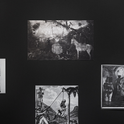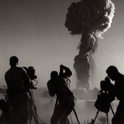Recent books have tried to capture the essence of India—but is it possible to draw conclusions from a country of a billion people?
Behind the Beautiful Forevers: Life, Death, and Hope in a Mumbai Slum By Katherine Boo (Granta, £14.99)
India Becoming: A Portrait of Life in Modern India By Akash Kapur (Riverhead, £17)
Following Fish: Travels Around the Indian Coast By Samanth Subramanian (Atlantic, £12.99)
For a certain type of Indian novelist writing in English, the idea of India is both blessing and scourge. A blessing in terms of readership, for since the country has come to be considered a rising economic power, interest has increased in novels that offer a picture of “the new India.” A scourge because, for many writers, a novel isn’t a lightly disguised informative tract. They may have other ambitions—to tell a story or offer a sense of place that has little to do with political geography.
These writers can take inspiration from Gustave Flaubert, one of the forefathers of the modern novel, who wrote in an 1850 letter, “La bêtise consiste à vouloir conclure” (“Stupidity consists in wanting to draw conclusions”). But while novelists may decline to serve up conclusions, a resurgence in narrative non-fiction about India now offers to fill the gap.
The new breed of non-fiction in India either concentrates on a small locus—the bar-dancing industry, for example, in Sonia Faleiro’s lauded Beautiful Thing, or a biography of a city, in Suketu Mehta’s accomplished, insightful Maximum City: Bombay Lost and Found—or the traditional journey structure which has its ties with the 18th-century travelogue, as well as 20th-century classics like Eric Newby’s A Short Walk in the Hindu Kush. But the new non-fiction about India still aims to tell the reader a conclusive story about India. Pages of closely observed reporting, written in the conventions of character-driven fiction, find themselves summed up in formulations that can feel bizarrely crude, as two new portraits of India show.
Katherine Boo’s deeply researched, often beautifully written Behind the Beautiful Forevers: Life, Death, and Hope in a Mumbai Slum centres around a family of ragpickers in Annawadi, a slum near Mumbai’s international airport. Throughout the book, Boo acts as a Flaubertian narrator—present everywhere, visible nowhere, telling us what each person’s thoughts and emotions are as we watch them act.
The book opens with Abdul, the eldest son, being chased by policemen under suspicion of murdering another resident of the slum. Later, when Abdul is being held by the police, who try to extort bribes from his family before a charge is registered, the following paragraph appears: “The Indian criminal justice system was a market like garbage, Abdul now understood. Innocence and guilt could be bought and sold like a kilo of polyurethane bags.” This is problematic not only because of the tabloid-like simplicity of the assertion, but because the statement has been put into indirect speech. There can be something inauthentic, even opportunistic, in the way Boo smoothes over the gap between the novelistic artifice of omniscient narration and the journalistic process of collecting testimony from her subjects.
In her afterword, Boo describes the lengthy interviewing she carried out with her translators: “When I sought to grasp, retrospectively, a person’s thinking at a given moment, or when I had to do repeated interviews in order to understand the complexity of someone’s views—very often the case—I used paraphrase.” This isn’t an unusual convention in narrative non-fiction, or even longform journalism—VS Naipaul’s seminal India: A Million Mutinies Now also features implausibly focused conversations with people the narrator meets, who often provide their own gloss on the social significance of their experience. But in Naipaul’s case, one is always aware of the narrator as a distinct voice (brilliant and overbearing), with his own point of view. There is no sheen of objectivity when he remarks upon “the smallness of Indian expectations” or notes that “Cruelty... was in the nature of Indian family life.” Boo is not averse to these summings-up either: “As group identities based on caste, ethnicity, and religion gradually attenuated, anger and hope were being privatised, like so much else in Mumbai,” she remarks early on. Yet often her conclusions seem put into the mouths or thoughts of her cast of real people: the putative female slum lord, Asha, we’re told, considers guilt “a luxury emotion.”
The book’s cinematic touches add to the impression that each scene is being presented to the reader directly, unmediated by a narrator. Boo opens with Abdul’s flight from the police and then, after this prologue, the reader is instructed to “Rewind, see Abdul running backward, away from the station and the airport, toward home.” Boo manipulates the narrative as confidently as though it were fiction, or a feature film, but one is aware of the manipulation while being encouraged to believe it isn’t taking place.
Boo’s account is vivid and full of insight, her reporting excellent. Although the book is structured around the death of a slum tenant and the subsequent court case, it appears to give a realistic account of what daily life in Annawadi feels like. She achieves what drier if much earlier accounts, such as Kalpana Sharma’s Rediscovering Dharavi: Stories from Asia’s Largest Slum (2000) don’t always manage. Sharma’s book was based on oral histories, but Boo’s approach and the quality of her writing allow her to better convey the texture of lived experience. Yet in constructing this engaging world, Boo’s novelistic removal of herself and her researchers from the telling, at times left me uneasy.
Akash Kapur is a novelist as well as a journalist, and, as in Boo’s book, many of the strengths of India Becoming: A Portrait of Life in Modern India are those of a good novel. Kapur’s book is a story of his return from America to India—specifically to the alternative community of Auroville, founded outside Pondicherry in 1968. Here he and his wife build a house and live a vaguely Walden-like existence; Kapur takes evening walks into the forest and delights that his two children will play in the environment where he, child of an Indian father and an American mother, grew up. The book, written in short, elegant sections, covers a span of years from 2003.
At times, India Becoming reminded me of a novel Kapur has championed, Upamanyu Chatterjee’s English August: An Indian Story (1988). Like Chatterjee’s slacker civil-servant protagonist Agastya Sen, Kapur often seems appalled by the country to which he has returned. Unlike Agastya, though, he often takes the changes he observes as something of a personal affront. Kapur wonders “what it meant to be Indian at the turn of the 21st century”; later, when writing about a young female call-centre worker’s attitudes towards sex and marriage, he observes, “For all India’s modernity, the weight of tradition was still formidable.” The unfairness of her background and expectations thrust upon her make Kapur angry: “I found myself questioning the new India. What good was all the money, all the big houses and cars, the fancy jobs, if... women like Selvi just went running back to their villages when their families ordered them to?” It’s a fair question, but not relevant only to India: surely the same sort of question could be asked of young, well-educated women from strict conservative communities in America or other developed countries?
Kapur’s analysis is tilted towards exploring populations in transition, like call-centre workers in Bangalore. But he then extrapolates, as the writer of anecdotal non-fiction must, to the whole country, and his experience is not always representative. He states that Indian women have always worked “in shops, offices, hospitals, farms, and markets” but less so in the professions. Yet teaching, for example, was something that women did in the Bombay of the late 1930s onwards—my grandmother was one of them.
Earlier in the book, he describes himself as having grown up in rural India—a description that is both strictly true and utterly misleading when applied to an “experimental” township like Auroville, which hardly resembles the rest of rural India, as Kapur acknowledges later on in the narrative. Kapur’s background and upbringing are statistically unusual in middle-class India, just as the fictional Agastya Sen’s are. That doesn’t matter in itself, but there is a sense of being out of touch with the world he maps that Kapur doesn’t always want to acknowledge. His angst when he realises that the fumes from a rubbish dump two miles from his house are poisoning his children is both understandable and also expected from someone who’s been living away from India for a long time. Most urban and many rural Indians expect nothing other than terrible pollution and the repeated desecration of the environment.
Kapur’s response is the anguish of a person who has a choice about which country to live in. Even Naresh Fernandes, the Ivy League-educated Time OutMumbai editor who is Kapur’s friend and guide in Mumbai, chuckles when Kapur points out the “contrast” between the swanky Bandra bar where they have been eating french fries with wasabi sauce, and the family sleeping outside on the pavement. “I should write about that,” says Kapur. “It would be a bit of a cliché, wouldn’t it?” Fernandes responds.
Later, Kapur reflects that the “new happy narrative” of developing India is “as simplistic as the old, depressing one.” “I didn’t know which India was the real one,” he writes.
But why should there be one real India? Do we expect there to be one real America, or one real France? A billion people live in India; are they all expected to be bit-players in the same story? One gets the impression that publishers expect general statements from these non-fiction writers about the state of the entire country which work against their flair for nuance, for observation, for subtlety. Instead, at times, the editing of these books seems to try to drive them between nuance and the bludgeoning conclusion, in a way that doesn’t seem to serve either.
Among the new non-fiction, Samanth Subramanian’s Following Fish is a slighter, more whimsical book. Subramanian, another Indian expatriate returned, works as a journalist in Delhi. The book, as the title suggests, is a series of vignettes in different coastal communities around the country. In Kolkata, Subramanian—who doesn’t, it turns out, particularly care for fish as food—eats the famed hilsa, a river fish; in Gujarat, he visits a shipyard; in Kerala he drinks palm toddy; in Tamil Nadu, he visits a Catholic fishing community; in Mumbai, he eats at a legendary restaurant established in the early 20th century to cater to the mill workers from the coast.
Whereas Boo and, to an extent, Kapur structure their books around the scenes they describe or the characters they follow, Subramanian’s personal observations are the centre of his narrative. There is a smile in his writing which makes it easy to read, though occasionally he over-describes, or tosses in a literary reference that appears somewhat extraneous—“Marcel Proust once wrote about the abrupt thrill of a fish breaking the surface of water, comparing it to the flash of metaphor in prose.” But there are also many nice observations. Goa, writes Subramanian, runs on “an economy of idleness,” a nod both to its status as a tourist destination and to the Goan Portuguese word susegad, which might translate as something like easy-goingness. He describes young women “meditatively de- veining prawns with nimble fingers,” or, in a traditional restaurant, “waiters in strategic positions of lethargy.”
Subramanian’s book is short and, in a sense, light in its ambition: he concludes only that coastal communities throughout the country resemble each other, and that fishing is still an “elemental” activity “composed of water and air and light and space, all arranged in precarious balance around a central idea of a man in a boat, waiting for a bite.” His narrative declines to strive for an idea of India, still less “the real India,” and that is its strength.
Behind the Beautiful Forevers: Life, Death, and Hope in a Mumbai Slum By Katherine Boo (Granta, £14.99)
India Becoming: A Portrait of Life in Modern India By Akash Kapur (Riverhead, £17)
Following Fish: Travels Around the Indian Coast By Samanth Subramanian (Atlantic, £12.99)
For a certain type of Indian novelist writing in English, the idea of India is both blessing and scourge. A blessing in terms of readership, for since the country has come to be considered a rising economic power, interest has increased in novels that offer a picture of “the new India.” A scourge because, for many writers, a novel isn’t a lightly disguised informative tract. They may have other ambitions—to tell a story or offer a sense of place that has little to do with political geography.
These writers can take inspiration from Gustave Flaubert, one of the forefathers of the modern novel, who wrote in an 1850 letter, “La bêtise consiste à vouloir conclure” (“Stupidity consists in wanting to draw conclusions”). But while novelists may decline to serve up conclusions, a resurgence in narrative non-fiction about India now offers to fill the gap.
The new breed of non-fiction in India either concentrates on a small locus—the bar-dancing industry, for example, in Sonia Faleiro’s lauded Beautiful Thing, or a biography of a city, in Suketu Mehta’s accomplished, insightful Maximum City: Bombay Lost and Found—or the traditional journey structure which has its ties with the 18th-century travelogue, as well as 20th-century classics like Eric Newby’s A Short Walk in the Hindu Kush. But the new non-fiction about India still aims to tell the reader a conclusive story about India. Pages of closely observed reporting, written in the conventions of character-driven fiction, find themselves summed up in formulations that can feel bizarrely crude, as two new portraits of India show.
Katherine Boo’s deeply researched, often beautifully written Behind the Beautiful Forevers: Life, Death, and Hope in a Mumbai Slum centres around a family of ragpickers in Annawadi, a slum near Mumbai’s international airport. Throughout the book, Boo acts as a Flaubertian narrator—present everywhere, visible nowhere, telling us what each person’s thoughts and emotions are as we watch them act.
The book opens with Abdul, the eldest son, being chased by policemen under suspicion of murdering another resident of the slum. Later, when Abdul is being held by the police, who try to extort bribes from his family before a charge is registered, the following paragraph appears: “The Indian criminal justice system was a market like garbage, Abdul now understood. Innocence and guilt could be bought and sold like a kilo of polyurethane bags.” This is problematic not only because of the tabloid-like simplicity of the assertion, but because the statement has been put into indirect speech. There can be something inauthentic, even opportunistic, in the way Boo smoothes over the gap between the novelistic artifice of omniscient narration and the journalistic process of collecting testimony from her subjects.
In her afterword, Boo describes the lengthy interviewing she carried out with her translators: “When I sought to grasp, retrospectively, a person’s thinking at a given moment, or when I had to do repeated interviews in order to understand the complexity of someone’s views—very often the case—I used paraphrase.” This isn’t an unusual convention in narrative non-fiction, or even longform journalism—VS Naipaul’s seminal India: A Million Mutinies Now also features implausibly focused conversations with people the narrator meets, who often provide their own gloss on the social significance of their experience. But in Naipaul’s case, one is always aware of the narrator as a distinct voice (brilliant and overbearing), with his own point of view. There is no sheen of objectivity when he remarks upon “the smallness of Indian expectations” or notes that “Cruelty... was in the nature of Indian family life.” Boo is not averse to these summings-up either: “As group identities based on caste, ethnicity, and religion gradually attenuated, anger and hope were being privatised, like so much else in Mumbai,” she remarks early on. Yet often her conclusions seem put into the mouths or thoughts of her cast of real people: the putative female slum lord, Asha, we’re told, considers guilt “a luxury emotion.”
The book’s cinematic touches add to the impression that each scene is being presented to the reader directly, unmediated by a narrator. Boo opens with Abdul’s flight from the police and then, after this prologue, the reader is instructed to “Rewind, see Abdul running backward, away from the station and the airport, toward home.” Boo manipulates the narrative as confidently as though it were fiction, or a feature film, but one is aware of the manipulation while being encouraged to believe it isn’t taking place.
Boo’s account is vivid and full of insight, her reporting excellent. Although the book is structured around the death of a slum tenant and the subsequent court case, it appears to give a realistic account of what daily life in Annawadi feels like. She achieves what drier if much earlier accounts, such as Kalpana Sharma’s Rediscovering Dharavi: Stories from Asia’s Largest Slum (2000) don’t always manage. Sharma’s book was based on oral histories, but Boo’s approach and the quality of her writing allow her to better convey the texture of lived experience. Yet in constructing this engaging world, Boo’s novelistic removal of herself and her researchers from the telling, at times left me uneasy.
Akash Kapur is a novelist as well as a journalist, and, as in Boo’s book, many of the strengths of India Becoming: A Portrait of Life in Modern India are those of a good novel. Kapur’s book is a story of his return from America to India—specifically to the alternative community of Auroville, founded outside Pondicherry in 1968. Here he and his wife build a house and live a vaguely Walden-like existence; Kapur takes evening walks into the forest and delights that his two children will play in the environment where he, child of an Indian father and an American mother, grew up. The book, written in short, elegant sections, covers a span of years from 2003.
At times, India Becoming reminded me of a novel Kapur has championed, Upamanyu Chatterjee’s English August: An Indian Story (1988). Like Chatterjee’s slacker civil-servant protagonist Agastya Sen, Kapur often seems appalled by the country to which he has returned. Unlike Agastya, though, he often takes the changes he observes as something of a personal affront. Kapur wonders “what it meant to be Indian at the turn of the 21st century”; later, when writing about a young female call-centre worker’s attitudes towards sex and marriage, he observes, “For all India’s modernity, the weight of tradition was still formidable.” The unfairness of her background and expectations thrust upon her make Kapur angry: “I found myself questioning the new India. What good was all the money, all the big houses and cars, the fancy jobs, if... women like Selvi just went running back to their villages when their families ordered them to?” It’s a fair question, but not relevant only to India: surely the same sort of question could be asked of young, well-educated women from strict conservative communities in America or other developed countries?
Kapur’s analysis is tilted towards exploring populations in transition, like call-centre workers in Bangalore. But he then extrapolates, as the writer of anecdotal non-fiction must, to the whole country, and his experience is not always representative. He states that Indian women have always worked “in shops, offices, hospitals, farms, and markets” but less so in the professions. Yet teaching, for example, was something that women did in the Bombay of the late 1930s onwards—my grandmother was one of them.
Earlier in the book, he describes himself as having grown up in rural India—a description that is both strictly true and utterly misleading when applied to an “experimental” township like Auroville, which hardly resembles the rest of rural India, as Kapur acknowledges later on in the narrative. Kapur’s background and upbringing are statistically unusual in middle-class India, just as the fictional Agastya Sen’s are. That doesn’t matter in itself, but there is a sense of being out of touch with the world he maps that Kapur doesn’t always want to acknowledge. His angst when he realises that the fumes from a rubbish dump two miles from his house are poisoning his children is both understandable and also expected from someone who’s been living away from India for a long time. Most urban and many rural Indians expect nothing other than terrible pollution and the repeated desecration of the environment.
Kapur’s response is the anguish of a person who has a choice about which country to live in. Even Naresh Fernandes, the Ivy League-educated Time OutMumbai editor who is Kapur’s friend and guide in Mumbai, chuckles when Kapur points out the “contrast” between the swanky Bandra bar where they have been eating french fries with wasabi sauce, and the family sleeping outside on the pavement. “I should write about that,” says Kapur. “It would be a bit of a cliché, wouldn’t it?” Fernandes responds.
Later, Kapur reflects that the “new happy narrative” of developing India is “as simplistic as the old, depressing one.” “I didn’t know which India was the real one,” he writes.
But why should there be one real India? Do we expect there to be one real America, or one real France? A billion people live in India; are they all expected to be bit-players in the same story? One gets the impression that publishers expect general statements from these non-fiction writers about the state of the entire country which work against their flair for nuance, for observation, for subtlety. Instead, at times, the editing of these books seems to try to drive them between nuance and the bludgeoning conclusion, in a way that doesn’t seem to serve either.
Among the new non-fiction, Samanth Subramanian’s Following Fish is a slighter, more whimsical book. Subramanian, another Indian expatriate returned, works as a journalist in Delhi. The book, as the title suggests, is a series of vignettes in different coastal communities around the country. In Kolkata, Subramanian—who doesn’t, it turns out, particularly care for fish as food—eats the famed hilsa, a river fish; in Gujarat, he visits a shipyard; in Kerala he drinks palm toddy; in Tamil Nadu, he visits a Catholic fishing community; in Mumbai, he eats at a legendary restaurant established in the early 20th century to cater to the mill workers from the coast.
Whereas Boo and, to an extent, Kapur structure their books around the scenes they describe or the characters they follow, Subramanian’s personal observations are the centre of his narrative. There is a smile in his writing which makes it easy to read, though occasionally he over-describes, or tosses in a literary reference that appears somewhat extraneous—“Marcel Proust once wrote about the abrupt thrill of a fish breaking the surface of water, comparing it to the flash of metaphor in prose.” But there are also many nice observations. Goa, writes Subramanian, runs on “an economy of idleness,” a nod both to its status as a tourist destination and to the Goan Portuguese word susegad, which might translate as something like easy-goingness. He describes young women “meditatively de- veining prawns with nimble fingers,” or, in a traditional restaurant, “waiters in strategic positions of lethargy.”
Subramanian’s book is short and, in a sense, light in its ambition: he concludes only that coastal communities throughout the country resemble each other, and that fishing is still an “elemental” activity “composed of water and air and light and space, all arranged in precarious balance around a central idea of a man in a boat, waiting for a bite.” His narrative declines to strive for an idea of India, still less “the real India,” and that is its strength.












